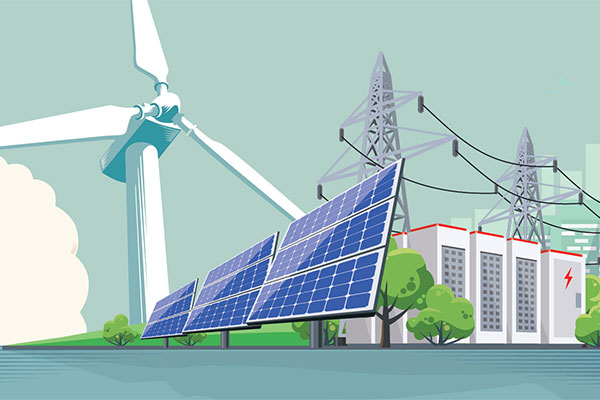According to a review by the SUN DAY Campaign of data just issued by the Federal Energy Regulatory Commission (FERC), solar, wind, and hydropower provided 85.7% of new U.S. electrical generating capacity added during the first two months of 2020 – swamping that provided by natural gas.
FERC’s latest monthly “Energy Infrastructure Update” report (with data through February 29, 2020) also reveals that wind and solar are on track to each provide more new generating capacity than natural gas over the next three years. Moreover, the mix of all renewables (i.e., biomass, geothermal, hydropower, solar, wind) will add nearly 51 gigawatts (GW) of new generating capacity to the nation’s total by February 2023 while that of natural gas, coal, oil, and nuclear power combined will actually decrease by almost 2 GW.
During the first two months of this year, 38 new “units” of solar totaling 987 megawatts (MW) were added to the U.S.’s total energy generating capacity accompanied by four units of wind (303 MW), and three units of hydropower (13 MW). By comparison, FERC reported only 218 MW (or seven units) of natural gas. There were no new capacity additions by coal, oil, nuclear power, biomass, or geothermal energy.
Renewable energy sources now account for 22.60% of the nation’s total available installed generating capacity and continue to expand their lead over coal (20.62%). [1] The generating capacity of just wind and solar is now at 12.58% of the nation’s total … and that does not include distributed (e.g., rooftop) solar. [2]
In addition, FERC data suggest that renewables’ share of generating capacity should increase significantly over the next three years. “High probability” generation capacity additions for wind, minus anticipated retirements, reflect a projected net increase of 26,167 MW while solar is foreseen growing by 22,593 MW. By comparison, net growth for natural gas will be only 21,822 MW.
While hydropower, geothermal, and biomass are all projected to experience net growth (1,903 MW, 178 MW, and 92 MW respectively), the generating capacity of coal, oil, and nuclear power are all projected to decline – by 19,082 MW, 3,060 MW, and 1,369 MW respectively. In fact, FERC reports no new coal capacity in the pipeline over the next three years and just 2 MW of new oil-based capacity.
Thus, if these numbers hold, over the next three years, renewable energy generating capacity should increase by at least 50,933 MW while that of fossil fuels and nuclear power should drop by 1,689 MW. And by spring 2023, renewable sources could account for more than a quarter of the nation’s total available installed generating capacity.
In fact, renewables’ share could be even higher. Over the past year, FERC has been regularly increasing its renewable energy projections in its monthly “Infrastructure” reports. For example, two months earlier, FERC forecast net growth over the next three years of 48,254 MW for renewable energy sources – i.e., 2,679 MW less than its latest data.
“The impacts of the global coronavirus crisis and the wild gyrations in international oil prices have yet to be reflected in FERC’s data,” noted Ken Bossong, Executive Director of the SUN DAY Campaign. “However, renewables – especially wind and solar – still seem poised to continue their rapid growth toward eventual market dominance.”
# # # # # # # # #
[1] Capacity is not the same as actual generation. Capacity factors for nuclear power and fossil fuels tend to be higher than those for most renewables. For example, in 2019, the U.S. Energy Information Administration (EIA) reported that renewables accounted for 18.2% of the nation’s total electrical generation – that is, somewhat less than their share of installed generating capacity (22.1%) for the same period. Conversely, coal’s share of generating capacity in 2019 was 20.9% while its share of electrical generation was 23.3%.
[2] FERC generally only reports data for utility-scale facilities (i.e., those rated 1-MW or greater) and therefore its data do not reflect the capacity of distributed renewables, notably rooftop solar PV which – according to the EIA – accounts for nearly a third of the nation’s electrical generation by solar. That would suggest that total distributed and utility-scale solar capacity may be as much as 50% higher than that reported by FERC (3.7%) — i.e., more than 5%.













Comments